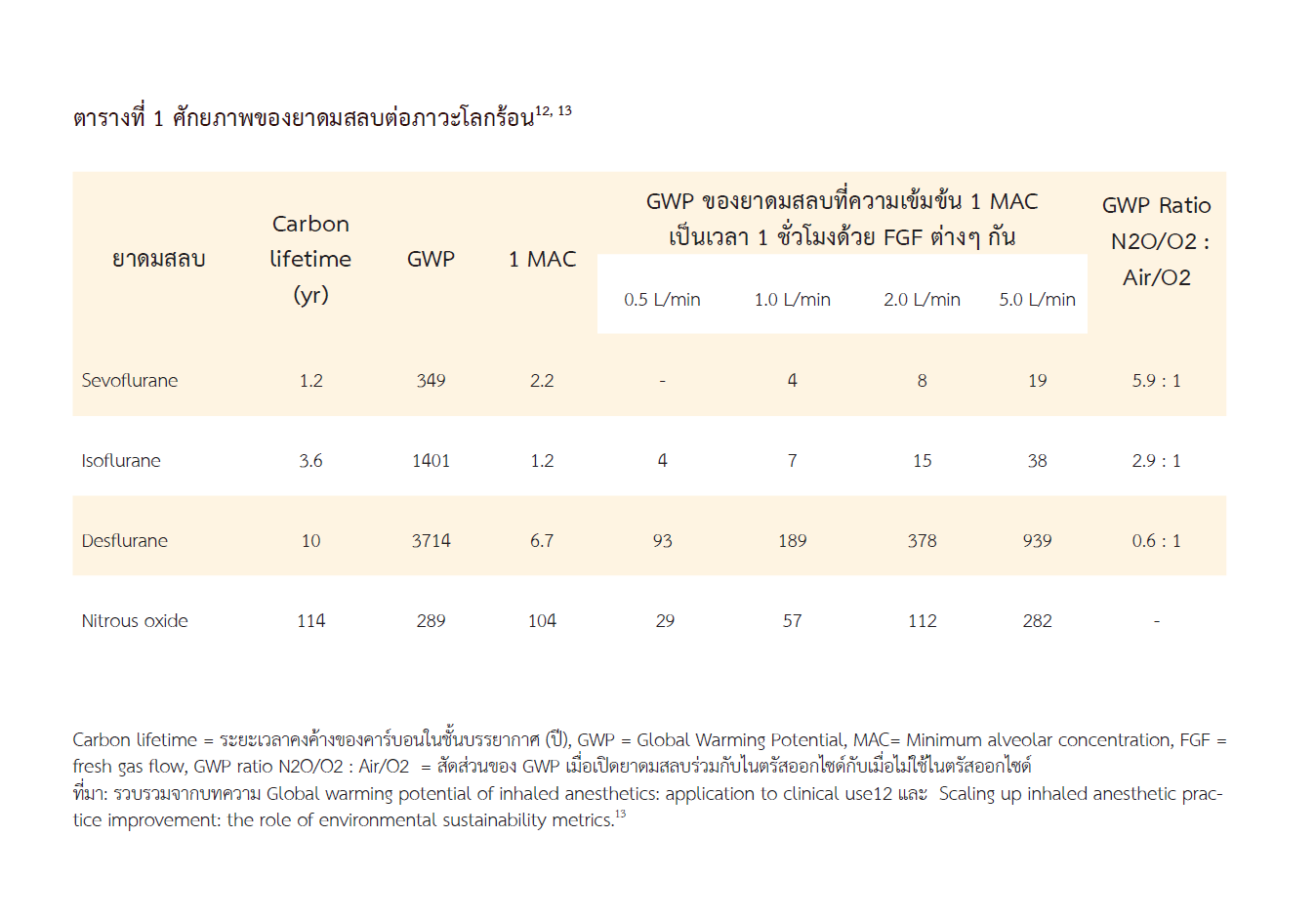ความสำคัญของการลดการปล่อยคาร์บอนในงานระงับความรู้สึก
Main Article Content
บทคัดย่อ
ก๊าซเรือนกระจกที่เกิดขึ้นตามธรรมชาติ มีความสำคัญต่อภูมิอากาศของโลก ที่สร้างสรรค์ให้สรรพสิ่งยังคงดำรงชีวิตอยู่ได้ แต่ก๊าซที่เกิดจากน้ำมือมนุษย์ จากการทำลายป่าต้นน้ำ การใช้ทรัพยากรที่มีจำกัดอย่างฟุ่มเฟือย ตลอดจนการเร่งรัดการผลิตในภาคอุตสาหกรรมและเกษตรกรรม ก่อให้เกิดมลพิษต่อสภาพแวดล้อมและวิกฤตภาวะโลกร้อนมานานนับศตวรรษ มนุษย์จึงจำเป็นต้องตระหนัก ร่วมแรงร่วมใจกันใช้องค์ความรู้และเทคโนโลยีที่มีอยู่ ในการพัฒนากระบวนการลดการปล่อยคาร์บอนสู่ชั้นบรรยากาศ โดยอาศัยพื้นฐานการประเมินวัฏจักรชีวิตของผลิตภัณฑ์เป็นบรรทัดฐาน
ในแต่ละวัน บุคลากรวิสัญญีเป็นผู้มีบทบาทสำคัญ นอกเหนือจากการดูแลผู้ป่วยอย่างใกล้ชิดแล้ว ยังมีหน้าที่ในการช่วยลดปริมาณคาร์บอนจากการปฏิบัติงาน ด้วยการเลือกใช้เทคนิคการระงับความรู้สึกแบบเฉพาะส่วนและก๊าซที่ใช้ขับเคลื่อนยาดมยาสลบในอัตราต่ำเป็นอันดับต้นๆ หลีกเลี่ยงผลิตภัณฑ์ เวชภัณฑ์และก๊าซทางการแพทย์ ที่มีปริมาณคาร์บอนสูง การส่งผลต่อภาวะโลกร้อน ระยะเวลาคงค้างอยู่ในบรรยากาศ และชีวมลพิษสะสม เพื่อประโยชน์ที่เกิดขึ้นต่อสภาพแวดล้อมของโลกใบนี้
Article Details
เอกสารอ้างอิง
1. ประวัติศาสตร์และวัฒนธรรม.ชีวประวัติของ Thomas Newcomen ผู้ประดิษฐ์ Steam engine[อินเตอร์เน็ต].2562[เข้าถึงเมื่อ13 เม.ย.2564].เข้าถึงได้จาก: https://www.greelane.com/th/มนุษยศาสตร์/ประวัติศาสตร์และวัฒนธรรม/thomas-newcomen-profile-1992201
2. Wikipedia. ปรากฏการณ์เรือนกระจก[อินเตอร์เน็ต].2557[เข้าถึงเมื่อ 13 ก.พ. 2564].เข้าถึงได้จาก: https://th.wikipedia.org/wiki/ปรากฏการณ์เรือนกระจก
3. สำนักอนามัยสิ่งแวดล้อม กรมอนามัย กระทรวงสาธารณสุข. สถานบริการสาธารณสุขกับการประเมิน
Carbon Footprint[อินเตอร์เน็ต].2557[เข้าถึงเมื่อ 13 ก.พ. 2564]. เข้าถึงได้จาก:http://203.157.71.139/group_sr/allfile/1588988146.pdf.
4. อรุณี อิ้วเจริญ. การประเมินก๊าซเรือนกระจก(GHGs Emission Assessment)[อินเตอร์เน็ต].[เข้าถึงเมื่อ 28 มี.ค. 2564].เข้าถึงได้จาก: https://gcipthai.org/files/announced/Arunee_GHGs-emission.pdf.
5. อรพรรณ บุญพร้อม. LCA [อินเตอร์เน็ต].2552[เข้าถึงเมื่อ 28 มี.ค. 2564].เข้าถึงได้จาก: https://en.mahidol.ac.th/EI/1089_4.html.
6. มณฑาสินี หอมหวาน. พลังงานทดแทน พลังงานทางเลือกใหม่สำหรับอนาคต Renewable energy: a new way to save our environment.นักบริหาร2555;32(1):100-4.
7. สำนักงานสิ่งแวดล้อมและองค์การความร่วมมือระหว่างประเทศของญี่ปุ่น(JICA). คู่มือคลายร้อนให้โลกที่รัก.กรุงเทพฯ:สำนักงานสิ่งแวดล้อม;2558.
8. การไฟฟ้าฝ่ายผลิตแห่งประเทศไทย (Electricity Generating Authority of Thailand). บทบาทของประเทศไทยกับการลดก๊าซเรือนกระจก[อินเตอร์เน็ต].2559[เข้าถึงเมื่อ 12 เม.ย. 2564].เข้าถึงได้จาก https://www.egat.co.th/index.php?option=com_content&view=article&id=1746:article-20161114-01&catid=49&Itemid=251.
9. Guzman-Reyes S, Pivalizza EG. Gender distribution in professional anesthesiology activities. Anesth Analg2019 ;129(5):e179-80.
10. Yeoh CB, Lee KJ, Coric V, Tollinche LE. Simple green changes for anesthesia practices to make a difference. EC Clinical and Medical Case Reports2020; 3(12):1-6.
11. Jones RS, West E. Environmental sustainability in veterinary anaesthesia. Veterinary Anaesthesia and Analgesia2019; 46(4):409-20.
12. Ryan SM, Nielsen CJ. Global warming potential of inhaled anesthetics: application to clinical use. Anesth Analg2010; 111(1):92-8.
13. Sherman JD, Berkow L. Scaling up inhaled anesthetic practice improvement: the role of environmental sustainability metrics. Anesth Analg2019; 128(6):1060-2.
14. Yuwapattanawong K , Nuchpramool P, Vitayaburananont P. Carbon dioxide absorbent. Vajira Medical Journal 2016; 60(1):125-33.
15. Van Norman GA, Jackson S. The anesthesiologist and global climate change: an ethical obligation to act. Current Opinion in Anesthesiology 2020; 33(4):577-83.






